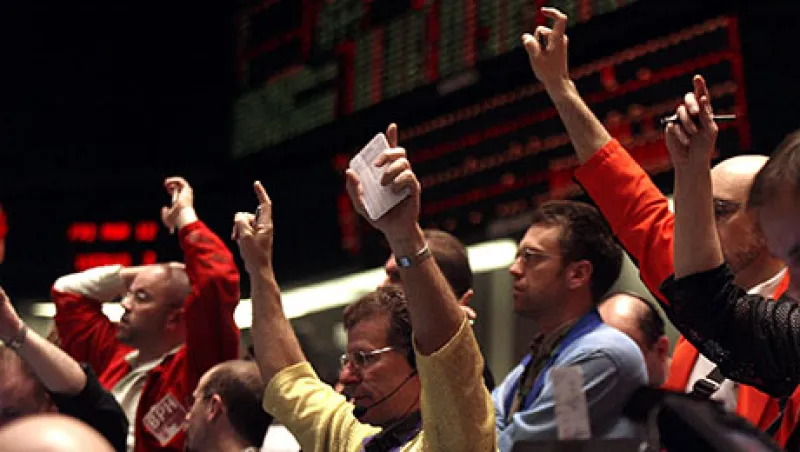Bond market participants expect Treasury yields to move higher in 2014, as tapering of the Federal Reserve’s quantitative easing program continues and the economy progresses on at least a moderate growth path.
Yields jumped higher in 2013 after the Fed indicated in the spring and summer that it would likely soon reduce its $85 billion in monthly bond purchases — which, as it turned out, the Federal Open Market Committee did not announce until its December 17–18 meeting. Many Fed watchers expect the central bank to continue reducing its bond purchases by $10 billion per monthly meeting, which would mean quantitative easing could be wrapped up by October.
The ten-year Treasury yield soared 126 basis points last year to end at 3.04 percent. The Barclays Capital U.S. Treasury index fell 2.8 percent in 2013, its first decline since 2009.
“It’s baked in that the Fed has indicated a reduced demand for ten-year Treasuries,” says Guy LeBas, managing director of fixed-income strategies for New York–based financial services firm Janney Montgomery Scott. He thinks the ten-year Treasury yield will gradually rise to 3.45 percent by the end of 2014. It was at 2.87 percent as of January 14.
Real ten-year Treasury yields have averaged 2.5 percent since 1960. Assuming an inflation rate of 2 percent, that would imply a nominal ten-year yield of 4.5 percent. But LeBas says that the nominal rate isn’t in the cards because the economy isn’t strong enough. He predicts economic growth of 2.1 percent to 2.5 percent for 2014. “There has been underinvestment in the economy by business really since 2002,” he says. “Long-term productivity growth has slowed, which limits economic growth.”
Others are more bullish. Chris Rupkey, chief financial economist at Bank of Tokyo–Mitsubishi UFJ in New York, expects the economy to expand 2.9 percent this year, up from his projection of 2.7 percent for 2013. Boosting the economy are reductions in federal spending cuts and buoyant state and local spending, as well as residential spending, Rupkey says.
“One thing you can be sure of is, the unemployment rate is coming down, and it’s not just because people are dropping out of the labor force,” Rupkey continues. The unemployment rate stood at 6.7 percent in December. Rupkey predicts the ten-year Treasury yield will end the year at 3.5 percent to 3.6 percent.
Gary Schlossberg, senior economist at Wells Capital Management in San Francisco, projects gross domestic product to grow at least 3 percent this year and sees the ten-year Treasury yield finishing 2014 at 3.75 percent. The economy will benefit from strong consumer spending, thanks to gains in household wealth and low fuel prices, he says. Businesses may begin to ramp up spending, in part as the policy environment becomes more clear. And “with deleveraging behind us, we’ll probably see a greater willingness to borrow,” Schlossberg says.
He also expects rising inflation to push Treasury yields higher. Schlossberg sees the consumer price index ascending almost 1.9 percent in 2014, compared with an expected 1.4 percent increase for 2013. “We see inflation up as excess capacity gets absorbed and businesses get some pricing power restored,” Schlossberg says. But others aren’t so concerned about inflation. LeBas expects the core consumer price index, which excludes food and energy, to rise 1.5 percent to 1.7 percent in 2014, about the same as in 2013.
Some experts say the short end of the yield curve will fare better because the economy does not yet have the momentum to force the Fed to raise the federal funds rate target. The target remains at zero to 0.25 percent, where the rate has been since the Fed’s meeting in December 2008. Analysts predict the rate to linger there for at least another year, especially with new Fed chair Janet Yellen, a reputed dove, at the helm.
“We should get a steepening yield curve,” Schlossberg says. “The Fed has every intention of anchoring money market rates near zero, probably well into 2015.” He thinks the two-year Treasury yield will finish the year at 0.6 percent to 0.7 percent. It traded recently at 0.39 percent. The Fed’s steadfastness on short-term rates makes the five-year note attractive, LeBas says. “There should be a lot of steepness between the three-year and the five-year.” He thinks the Fed is unlikely to move on rates before the first quarter of 2016.
But Bank of Tokyo’s Rupkey believes the Fed may hike rates this year. “The economy is strong enough to stand on its own two feet,” he says. “This Fed has eased longer into an expansion than any other Fed out there. It’s highly unusual.” Rupkey says he wouldn’t be surprised if the Fed raises rates twice this year, pushing the fed funds to 0.75 percent and the two-year Treasury yield to 2 percent at year-end.
Get more on banking and capital markets.







